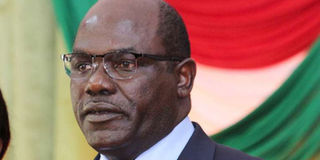Boundaries and electoral review to cost Sh8bn

Independent Electoral and Boundaries Commission chairman Wafula Chebukati, on October 25, 2017 at the Bomas of Kenya, announces their readiness for the repeat election. After elections, review of boundaries is the next big task for the IEBC. PHOTO | KANYIRI WAHITO | NATION MEDIA GROUP
What you need to know:
- The commission said there would be extensive consultations with interested parties, public hearings and analysis of data.
Review of constituency boundaries over the next four years is expected to cost Sh8 billion, the electoral commission has told the parliamentary committee that oversees the implementation of the Constitution.
Independent Electoral and Boundaries Commission chairman Wafula Chebukati revealed the estimated costs to members of the Constitutional Implementation Oversight Committee at a closed-door meeting at Parliament on Thursday.
He later told journalists that the commission is still mapping out its programme of events and activities for the review expected to end by February 2021.
The Constitution sets the number of constituencies at 290.
“The commission has no power to add or reduce constituencies. Our job is to look at the census, which we were told will take place next year, 2019, work out the data and come up with the figures.
"We cannot change the number of constituencies, maybe the size,” Mr Chebukati said.
LOGISTICS
He said the considerations would be: whether the constituency is in an urban or rural area, its geographical size and whether it is densely or sparsely populated.
“The first stop is to engage the people,” said Mr Chebukati.
Documents from that meeting show that the money will be spent on 18 core areas: development of a strategy and work plan, an induction workshop for commissioners and senior management, staff training, acquisition of a Geographic Information System laboratory and associated equipment.
Other activities are: acquisition of an expert panel, addressing issues from the first review, boundaries harmonisation, design of the legal framework, procedures, processes and structures for delimitation, public hearings, public outreach, data acquisition, data analysis, legal petitions, evaluation, stakeholder engagement and preparation of reports and publication in the Kenya Gazette.
The commission said there would be extensive consultations with interested parties, public hearings and analysis of data.
After elections, review of boundaries is the next big task for IEBC. The current constituencies were created in 2010





